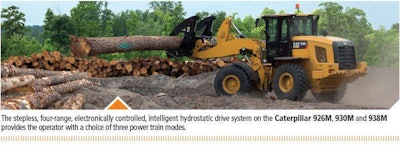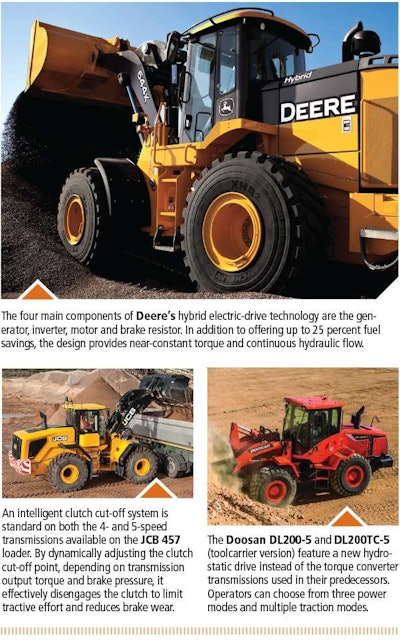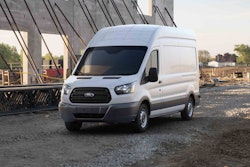Two types of transmissions are commonly found on wheel loaders: hydrostatic and torque converter. With torque converters, the lock-up feature is standard on some models and optional on others. “Hydrostatic is simpler and has fewer moving parts,” says Mike Stark, product specialist, heavy wheel loaders with Doosan. “Another benefit of hydrostatic is better power management and, with that, better fuel economy.
But, hydrostatic transmissions generate more heat than torque converter transmissions at higher speeds and in demanding applications. Hydrostatic is generally better in short run applications, while torque converters work better for longer runs. Both hydrostatic and torque converter are well-established technologies, familiar to both operators and service personnel.”


Modes match performance to applications. The fully automatic, electronically controlled ZF AS Tronic transmissions in Hyundai loaders have three modes, for example. Automatic Light (AL) is for traveling longer distances at higher speeds. Automatic Normal (AN) is for mixed applications that involve both short travel distances and occasional longer travel. Automatic Heavy (AH) is for use in constrained environments, such as all-day V- or L-pattern loading.
“With multiple modes, a self-adjusting clutch and self-diagnostic capabilities, these transmissions provide maximum productivity while controlling owning and operating costs,” says Corey Rogers, marketing manager, Hyundai Construction Equipment Americas.
Operators of Caterpillar loaders can choose from three modes that shape overall machine response. Hystat mode provides aggressive engine braking and enhances productivity in loading operations. Torque converter mode allows freewheeling on descents and around corners, reducing both operator fatigue and fuel use. Ice mode enhances traction in slippery underfoot conditions. “Our 926M, 930M, and 938M small wheel loaders all have this Powertrain Mode selection, since it’s part of the Caterpillar Intelligent Hydrostatic powertrain system,” says Joel Grimes, small wheel loader marketing engineer.









